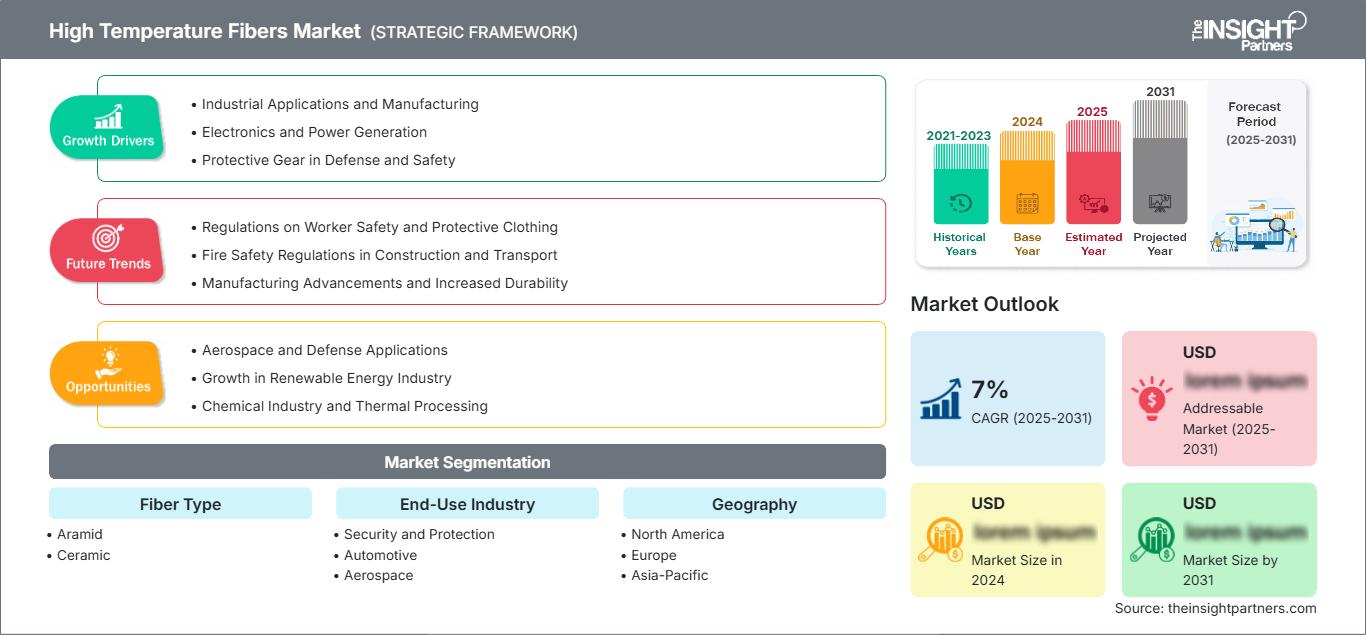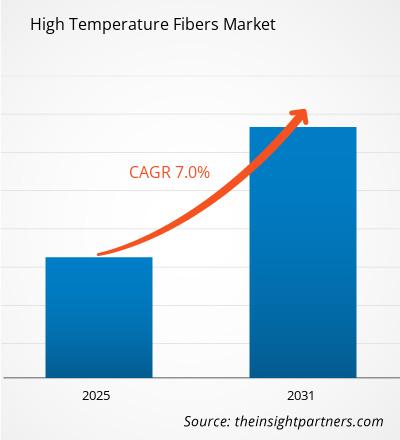Le marché des fibres haute température devrait enregistrer un TCAC de 7 % entre 2025 et 2031, avec une taille de marché passant de XX millions de dollars américains en 2024 à XX millions de dollars américains d'ici 2031.
Le marché des fibres haute température couvre l'analyse par type de fibre (aramide, céramique, autres), secteur d'utilisation finale (sécurité et protection, automobile, aérospatiale, industrie, électricité et électronique, autres) et géographie (Amérique du Nord, Europe, Asie-Pacifique, Moyen-Orient et Afrique, et Amérique du Sud et centrale). Les fibres haute température sont des fibres conçues pour maintenir la résistance et l'intégrité structurelle en cas de chaleur extrême. Elles sont fabriquées à partir de céramique, de carbure de silicium et de composites carbone-carbone. Ces fibres sont utilisées dans diverses industries, telles que l'aérospatiale, l'automobile et les systèmes de chauffage et de refroidissement industriels. Elles sont également utilisées dans la production de vêtements et d'équipements pour les travailleurs qui ont besoin d'une protection contre les chaleurs élevées. L'industrie aérospatiale est un utilisateur majeur de fibres haute température, car elles sont utilisées dans la fabrication de composants d'avions et de vaisseaux spatiaux exposés à des températures extrêmes.
Objectif du rapport
Le rapport sur le marché des fibres haute température de The Insight Partners vise à décrire le paysage actuel et la croissance future, les principaux facteurs moteurs, les défis et les opportunités. Cela fournira des informations aux différentes parties prenantes de l'entreprise, telles que :
- Fournisseurs de technologies/Fabricants : Comprendre l'évolution de la dynamique du marché et connaître les opportunités de croissance potentielles, leur permettant de prendre des décisions stratégiques éclairées.
- Investisseurs : Réaliser une analyse complète des tendances concernant le taux de croissance du marché, les projections financières du marché et les opportunités qui existent tout au long de la chaîne de valeur.
- Organismes de réglementation : Réglementer les politiques et surveiller les activités du marché afin de minimiser les abus, de préserver la confiance des investisseurs et de maintenir l'intégrité et la stabilité du marché.
Segmentation du marché des fibres haute température Type de fibre
- Aramide
- Céramique
Industrie d'utilisation finale
- Sécurité et protection
- Automobile
- Aérospatiale
- Industrie
- Électricité et électronique
Vous bénéficierez d’une personnalisation sur n’importe quel rapport - gratuitement - y compris des parties de ce rapport, ou une analyse au niveau du pays, un pack de données Excel, ainsi que de profiter d’offres exceptionnelles et de réductions pour les start-ups et les universités
Marché des fibres haute température: Perspectives stratégiques

-
Obtenez les principales tendances clés du marché de ce rapport.Cet échantillon GRATUIT comprendra une analyse de données, allant des tendances du marché aux estimations et prévisions.
Moteurs de croissance du marché des fibres haute température
- Applications industrielles et fabrication : Les fibres haute température sont utilisées dans les secteurs de la fabrication, de l'automobile et de l'énergie. Leur résistance aux températures élevées et au feu en fait un composant précieux pour les équipements de protection, l'isolation et les composants des fours, des fours, des moteurs et d'autres environnements similaires, car ces applications alimentent la croissance de ce marché dans les applications industrielles.
- Électronique et production d'énergie : Les fibres haute température sont utilisées dans un certain nombre de processus de fabrication électronique, de production d'énergie et d'applications connexes où les pièces sont soumises à des températures élevées. Elles gagnent également en popularité dans d'autres domaines, tels que les systèmes de refroidissement, les matériaux d'isolation et les revêtements de protection, car les industries visent une efficacité et une fiabilité accrues des systèmes électroniques et électriques.
- Équipements de protection pour la défense et la sécurité : Les fibres haute température jouent un rôle important dans la production de vêtements de protection par les militaires et autres personnels d'intervention d'urgence. Français Les fibres haute température ont l'avantage de résister à une chaleur extrême et d'être durables, ce qui conduit à une plus grande adoption dans les uniformes de protection, les équipements de lutte contre les incendies et les équipements tactiques, alimentant ainsi la croissance du marché dans les secteurs de la défense et de la sécurité.
Tendances futures du marché des fibres haute température
- Réglementations sur la sécurité des travailleurs et les vêtements de protection : les réglementations mondiales sur la sécurité des travailleurs, en particulier ceux exposés à des températures élevées, exigent également des fibres haute température. Ces fibres sont essentielles aux vêtements de protection, aux gants et aux équipements qui protègent les travailleurs de la métallurgie, de l'exploitation minière et des industries de lutte contre les incendies, propulsant ainsi le marché vers l'avant.
- Réglementations sur la sécurité incendie dans la construction et les transports : la sensibilisation croissante et la montée en puissance des organismes directeurs concernant les réglementations sur la sécurité incendie dans la construction, les modes de transport et les secteurs manufacturiers ont fait des fibres haute température une substance recherchée dans diverses applications. Les coussins de peignage, les revêtements et les fibres isolantes ignifuges contribuent à réduire les risques d'incendie et à accroître la sécurité, favorisant ainsi l'expansion du marché des matériaux de protection incendie.
- Progrès de la fabrication et durabilité accrue : Les progrès dans la fabrication des fibres haute température, principalement grâce à l'augmentation de la résistance à la chaleur et à la durabilité des matériaux, alimentent la croissance du marché. Les innovations dans la fabrication conduisent à un large éventail d'applications pour les fibres haute température ; elles sont actuellement utilisées dans divers secteurs, notamment l'automobile, la défense et la construction.
Opportunités de marché pour les fibres haute température
- Applications aérospatiales et de défense : Les applications aérospatiales et de défense nécessitent l'utilisation de fibres haute température, notamment pour l'isolation des avions, les vêtements de protection et certaines pièces de moteurs d'avions et de véhicules de défense. Compte tenu de l'augmentation du transport aérien et des dépenses de défense qui stimulent la croissance du secteur aérospatial, la demande pour ces fibres, qui présentent une résistance à la chaleur, continue de croître.
- Croissance du secteur des énergies renouvelables : L’essor du secteur des énergies renouvelables, notamment la production d’énergie solaire et éolienne, accroît particulièrement la demande en fibres haute température. Utilisées dans l’isolation thermique et les systèmes écoénergétiques, ces fibres soutiennent la transition mondiale vers une énergie plus propre et contribuent à renforcer la présence sur le marché des projets d’énergie verte.
- Industrie chimique et traitement thermique : Les fibres haute température sont utilisées dans divers domaines, comme la filtration, l’isolation et les équipements de protection individuelle (EPI) pour les opérations de traitement thermique. Avec l’expansion mondiale de l’industrie chimique, notamment sur les marchés en développement, le besoin de ces fibres dans des processus critiques tels que le raffinage et la production chimique augmente.
Aperçu régional du marché des fibres haute température
Les tendances régionales et les facteurs influençant le marché des fibres haute température tout au long de la période de prévision ont été détaillés par les analystes de The Insight Partners. Cette section aborde également les segments et la géographie du marché des fibres haute température en Amérique du Nord, en Europe, en Asie-Pacifique, au Moyen-Orient et en Afrique, ainsi qu'en Amérique du Sud et en Amérique centrale.
Portée du rapport sur le marché des fibres haute température
| Attribut de rapport | Détails |
|---|---|
| Taille du marché en 2024 | US$ XX million |
| Taille du marché par 2031 | US$ XX Million |
| TCAC mondial (2025 - 2031) | 7% |
| Données historiques | 2021-2023 |
| Période de prévision | 2025-2031 |
| Segments couverts |
By Type de fibre
|
| Régions et pays couverts |
Amérique du Nord
|
| Leaders du marché et profils d'entreprises clés |
|
Acteurs du marché des fibres haute température : densité : comprendre son impact sur la dynamique commerciale
Le marché des fibres haute température connaît une croissance rapide, porté par une demande croissante des utilisateurs finaux, due à des facteurs tels que l'évolution des préférences des consommateurs, les avancées technologiques et une meilleure connaissance des avantages du produit. Face à cette demande croissante, les entreprises élargissent leur offre, innovent pour répondre aux besoins des consommateurs et capitalisent sur les nouvelles tendances, ce qui alimente la croissance du marché.

- Obtenez le Marché des fibres haute température Aperçu des principaux acteurs clés
- Analyse historique (2 ans), année de base, prévision (7 ans) avec TCAC
- Analyse PEST et SWOT
- Taille du marché Valeur / Volume - Mondial, Régional, Pays
- Industrie et paysage concurrentiel
- Ensemble de données Excel
Rapports récents
Rapports connexes
Témoignages
Raison d'acheter
- Prise de décision éclairée
- Compréhension de la dynamique du marché
- Analyse concurrentielle
- Connaissances clients
- Prévisions de marché
- Atténuation des risques
- Planification stratégique
- Justification des investissements
- Identification des marchés émergents
- Amélioration des stratégies marketing
- Amélioration de l'efficacité opérationnelle
- Alignement sur les tendances réglementaires






















 Obtenez un échantillon gratuit pour - Marché des fibres haute température
Obtenez un échantillon gratuit pour - Marché des fibres haute température